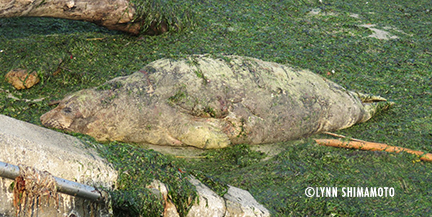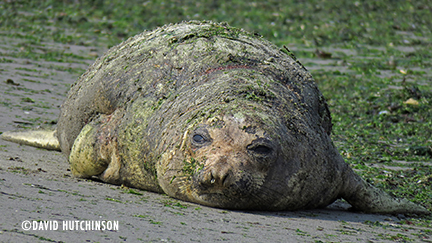Tank
Molting elephant seal makes a surprise appearance
Aug/10/17 08:39 PM

It was easy to see why callers were worried. The animal looked terrible - crusty with seaweed, a rough patchy coat, abrasions and cracked skin. “Ellies” go through an exhausting catastrophic molt each year and it isn’t a pretty sight. Over the course of a number of weeks, they spend many hours onshore as they shed the entire outer layer of skin and fur. They can sometimes develop infections. This large, rotund seal at the base of the steps to the beach was flipping sand over its back and pressing wet, cool sand along its sides with the foreflippers, trying to get some relief.
One of the callers who reported the seal, Judy stuck around til Lynn arrived and pitched in to help set the tape perimeter. SS First Responders David and Eilene arrived lugging high-visibility cones, stakes and signboards. Because the tide was rapidly receding, the tape barrier was constantly extended to create a safey zone. Scheduler Molly arrived and promptly lined up volunteers Jen, Karen, Melinda, Gordon, Aaron and Karin who talked to the hundreds of curious people who came by. Dr. Liz Mansi, who recently participated in NOAA’s consulting veterinarian training, came at Lynn’s request to assess the seal’s condition.

Elephant seals usually keep to the outer coast, but over the past decade, a small colony has established itself at Race Rocks Ecological Reserve in the Strait of Juan de Fuca. The first pup was born there in 2009. There are a few locations where individuals will haul out in the inland waters. According to WDFW Marine Mammal Investigations Unit’s Steve Jeffries, pups have now been born at Protection, Smith and Whidbey islands, Dungeness Spit and Race Rocks - with a total of 10 to 15 pups born annually. Over the years, Seal Sitters has responded to three female elephants seals, all located south of the Fauntleroy ferry terminal, the last one in 2011.
It is estimated that the Alki elephant seal was a subadult, 6ft long and about 600 lbs. Thanks to WDFW’s marine mammal biologist Dyanna Lambourn for reviewing photos.
Around noon, the huge seal made the move to the water’s edge, rolling along with powerful undulations - much like a tank - and slowly swam away. Seal Sitters volunteers and a transfixed public watched Tank slowly drift west and out of sight. Thanks to the many volunteers who help give this seal in need a little peace onshore today.







